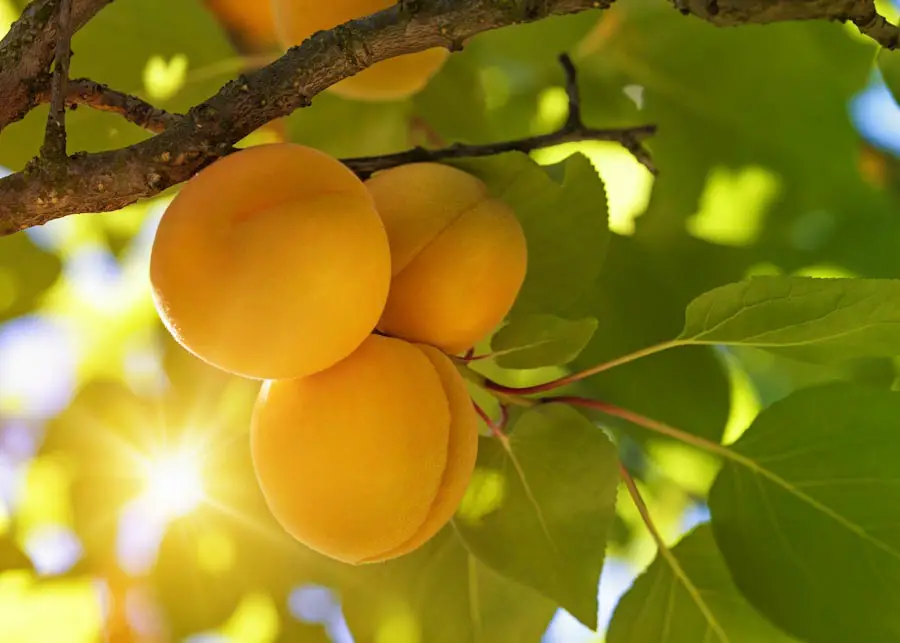
We may receive commissions from purchases made through links in this post, at no additional cost to you.
The first time I had fresh-picked apricots straight from the tree was not in Texas. It was in Santa Fe, New Mexico, and the taste was unforgettable. I had been traveling there with my family on our way to moving back to Texas after living in another state for five years.
So when we finally moved into our new East Texas home, the very first thing I bought for the new place was an apricot tree. Did I know much about growing apricots? No. Did I know that apricots were notoriously finicky to grow in Texas? Yes. But I did it anyway.
Now I’m so glad I did. The tree is thriving, and is producing apricots most seasons that taste even better than the ones in Santa Fe that started it all. But in hindsight, I realized that several things – some of them accidental – have made all the difference in how well the tree is growing and fruiting.
Obviously, not everything is in a gardener’s control…hello wild Texas weather. Riding the ups and downs of freezes and droughts and hurricanes and floods is one of the “joys” of gardening in Texas, right? But I can attest to the fact that it’s worth trying to figure out how to grow apricots wherever you live in the state.
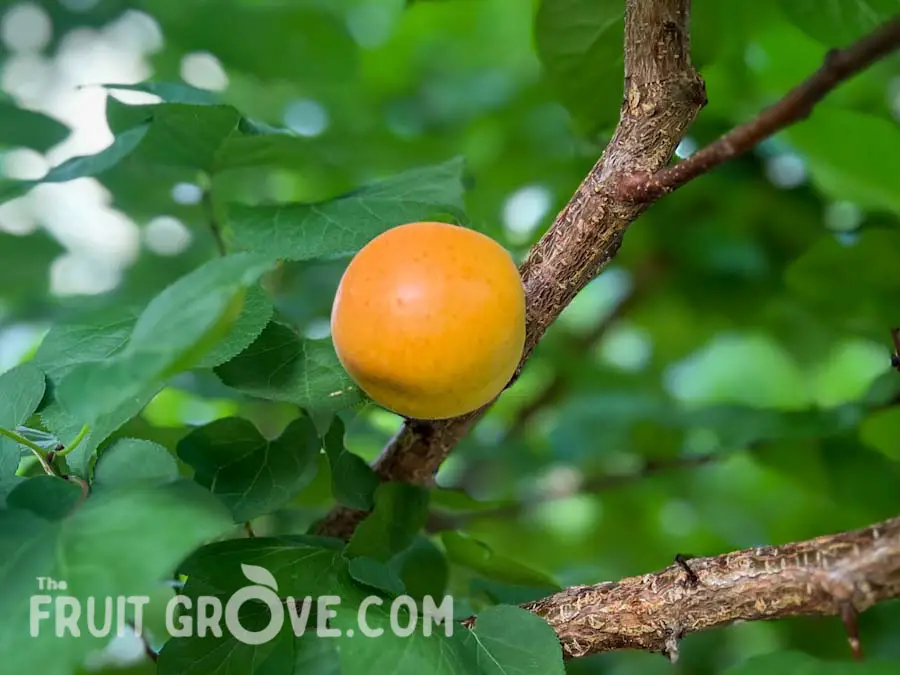
I certainly don’t have it all figured out – and, yes, some years I don’t get a good crop. But when I do…there is nothing like the taste of perfectly ripe, fresh-picked apricots from your own yard. In this article, I’ve included lots of practical tips for variety selection, planting location, disease and pest prevention, and cultural care that I (and others) have found beneficial for growing apricots successfully here in Texas.
Do Apricots Grow Well in Texas?
Apricots can grow well in Texas, but they probably won’t fruit every year. Choosing the right apricot cultivar for the climate and providing good cultural care will improve the chances of success. Late spring frost damage is the main reason for inconsistent fruiting.
To be fair, late frosts are a problem for apricot growers throughout the country (and many other parts of the world). This is why over 90% of commercial apricot production in the U.S. is done in California, where mild, dry springs, warm summers, and moderate winters are the norm.
Central Asia, where the apricot most likely originated, the Middle East, and Mediterranean climates are ideal for growing apricots. Turkey, Iran, and Uzbekistan are currently the largest commercial apricot regions in the world. Their climates tend to have mountainous terrain, moderately cold winters, dry summers, and short springs.

Apricots are very heat- and drought-tolerant – which is good news for the hot, dry summers throughout Texas. But they don’t like heavy soils, overly wet spring weather, or late spring frosts – which is bad news for our clay soil, spring storms, and widely fluctuating weather.
As we all know, Texas encompasses a nation’s worth of climates and terrain. Apricots are being grown successfully throughout the state, but different considerations have to be made for different locations: particularly, the average last frost date, amount of chill hours, soil composition, planting site, winter and spring moisture, and disease pressure.
With good variety selection and care, apricot trees can fruit for 30-50 years or more, even in Texas. (In this they have an advantage over another popular Texas fruit – peaches – which typically only live about 12 to 15 years.)
Learn more: The Life of an Apricot Tree: How Long Will It Bear Fruit?
Tips for Growing Apricots in Texas
Apricots are less disease-prone, more drought-tolerant, more heat- and cold-tolerant, and better adaptable to different soils than most other stone fruit trees. Read on for some Texas-specific (but applicable elsewhere, too) advice on how to help your apricot trees thrive.
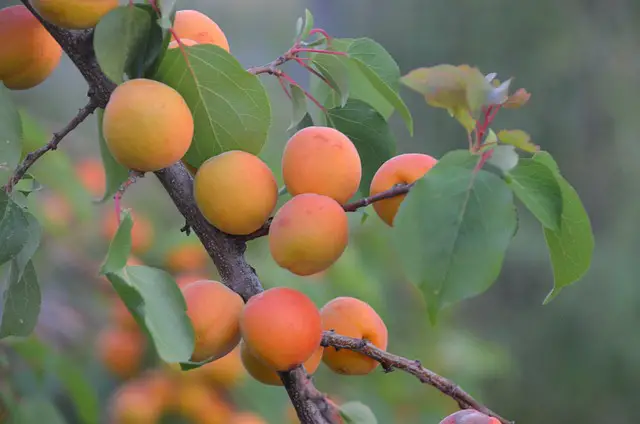
Plant on a Mound or Slope
Apricot trees tend to do best when planted on a mound, raised bed, or a slope of some kind. There are a couple of reasons for this – namely, frost protection and drainage.
Most stone fruit trees prefer well-draining soil, and apricot trees are no exception. Apricots hate wet feet, and many apricot problems stem from excessive soil moisture in the winter and spring. Planting on a slope or mound helps excessive soil moisture to drain more quickly so the tree doesn’t sit in soggy ground (a recipe for rot or fungal disease).
A slope doesn’t just allow soil moisture to drain away, but it also allows cold air to drain away. Frost sits much more heavily in low-lying hollows than it does on the tops of hills. Planting your apricot tree a little elevated makes it less susceptible to heavy frost damage (avoid exposed, windy hilltops, however).
A north- or east-facing slope is ideal, since it warms up more slowly in spring (delaying blooming), but gets more early morning sun on chilly spring mornings.
I noticed the positive effect of elevated planting with my ‘Golden Sweet‘ apricot tree. I planted it (not purposefully, if I’m honest) on a slightly mounded corner of my front yard, which slopes down toward the street. It blooms relatively late in the spring, even when January and February are mild, and has withstood March frosts well. The tree grows very vigorously without any supplemental watering, but the soil doesn’t stay saturated long after our heavy spring rains.
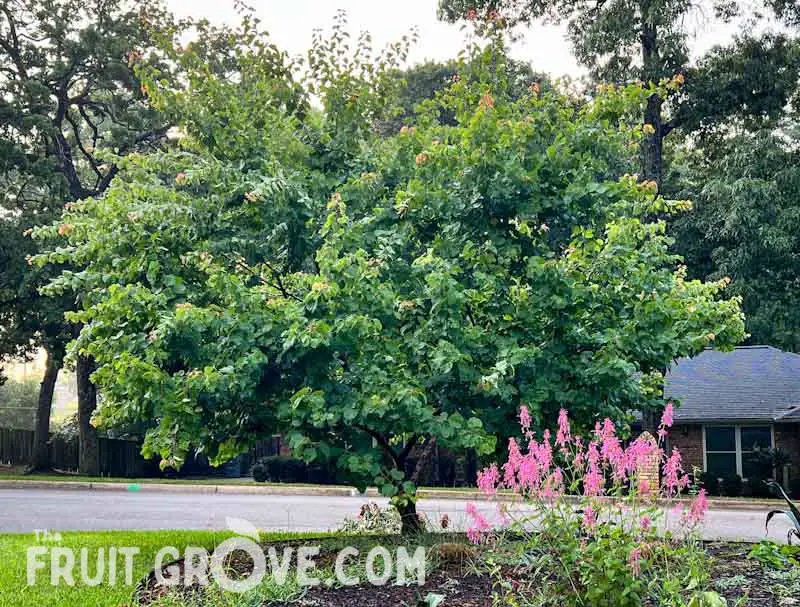
Spray for Pest and Disease Prevention
I think every Texas gardener knows that stone fruit trees need a spraying regimen if there’s any hope of a decent harvest. Apricots are somewhat less needy than peaches in this regard, however. Even though they are the least high-maintainance of all of the stone fruits (although that’s not saying much), apricot trees will still benefit from preventative sprays.
Some common Texas apricot tree pests include plum curculio, peach tree borers, spider mites, and aphids. Common diseases are coryneum blight (shothole), bacterial canker, and brown rot.
The most important way to prevent and control these issues is good care and cleanup. Prune away damaged or infested parts of the tree. Clean up fallen leaves, twigs, and fruit, which could spread disease or invite pests.
Overall good cultural care will keep the tree strong, prevent stress, and allow it to resist the ill affects of occasional pest and disease problems. When watering the tree, keep water from splashing onto the leaves as this could lead to fungal or bacterial infections. Prune yearly so the tree has good sun exposure and air flow.
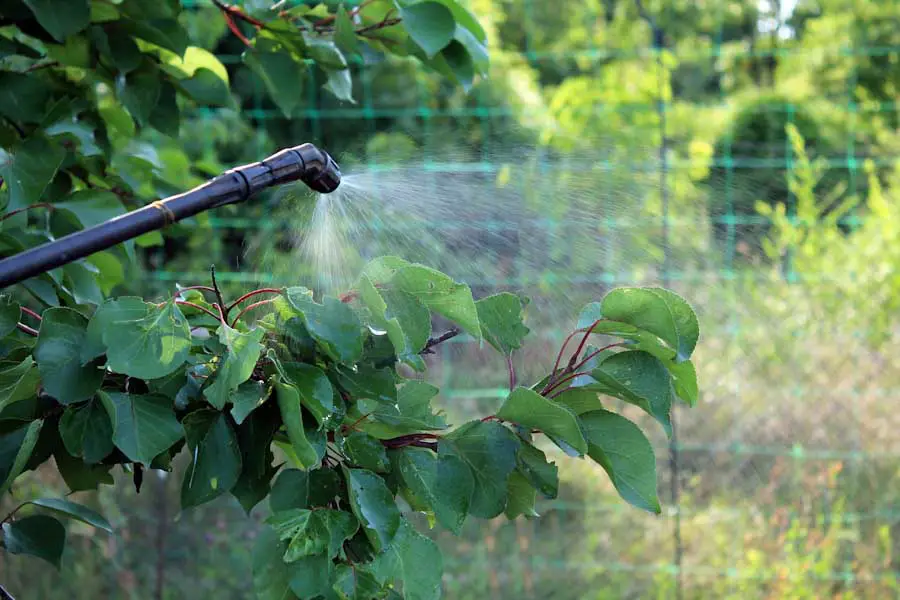
Natural horticultural oil or neem oil sprays will help prevent and treat many pest infestations such as aphids and mites. These oils suffocate the insects and can keep an infestation in check. Spraying with a copper fungicide will prevent or control shothole (coryneum blight). Spray first in the fall when about half of the leaves have fallen. Spray again in the spring just before bud break. (Always follow the package instructions!)
The safest thing to do is contact your nearby extension office, or talk to an expert at a local plant nursery. They will have the best information about which pests and diseases are a problem in your area, as well as suggestions on how best to prevent and treat problems.
Water Consistently after Planting
It’s always important to water a newly planted fruit tree frequently for the first several months, then continue regularly for the first year. But our hot Texas summers make this gardening rule even more important.
The year after I planted my first apricot tree, I thought I was watering adequately (if somewhat haphazardly). But once July and August came, the young tree started to wither and died back almost completely to the ground. I madly dumped a few gallons of water around it every day and, almost miraculously, new growth began to emerge from above the graft union.
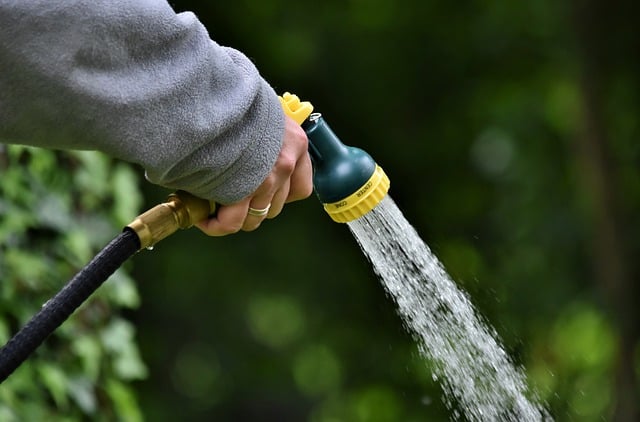
That new growth continued through the rest of the summer and fall (helped along by my continued frequent watering) and was about 8 feet tall by the time winter set in. Just a couple years later, the tree had become the sprawling, beautiful, 15-plus-feet-tall tree in the picture above, and has since provided the most delicious apricots I’ve ever eaten.
I don’t recommend my approach as a good watering strategy (the haphazard watering, almost-dying, then reviving technique). Instead, be very generous with water for a newly planted apricot tree, especially through its first hot summer.
In fact, you may consider not planting your apricot tree until early fall so it can escape the worst of the heat. In most parts of Texas, cold winter weather comes late enough that a tree planted in September will have plenty of time to establish before dormancy.
Once the tree has established, though, you probably won’t need to manually water it very often. The only time I water my apricot trees now is in prolonged periods of drought (more than a couple weeks). Apricot trees don’t like too much water when blossoming and developing fruit, and could cause fruit drop.
Fertilize or Compost for Trace Elements
Apricots generally do not need much fertilizer. Nitrogen will encourage adequate growth, but the tree will probably be able to get what it needs from the soil (especially if planted near a fertilized lawn).
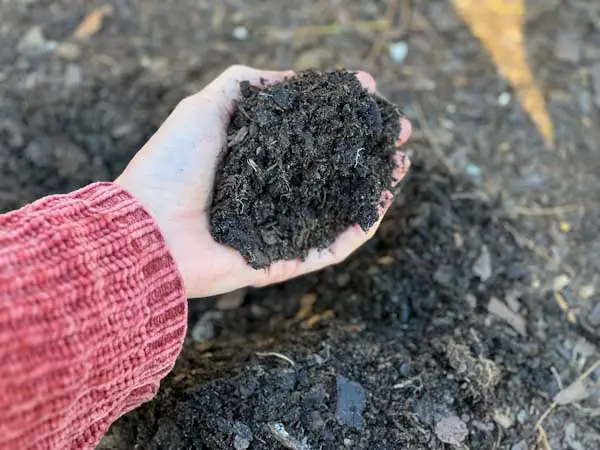
There is some recent evidence that apricot trees benefit from a good amount zinc, especially in the fall when next year’s flower buds are forming. An application of zinc sulfate to the soil, or a zinc-containing foliar spray, may improve the tree’s fruiting. I have not tried this, but it may be worth exploring. Consider getting a soil test to see if zinc or other trace minerals are lacking.
In general, a lack of trace elements (micronutrients) can keep an apricot tree from growing and fruiting its best. A simple way to provide what the tree needs is compost. Spread a layer of compost in the fall around the tree to the dripline (leaving a few inches of space around the trunk). The compost will break down over the winter and enhance the health and available nutrients in the soil.
Related: Fruitless Apricot Tree? These 10 Things May Be to Blame
Protect from Wildlife
If you grow apricots, be prepared to share them with the birds. Birds tend not to bother early-ripening apricot varieties as much. This may be because it’s early enough in the season that they aren’t noticing many ripe fruits around.

Lucky for me, my squirrels don’t seem to have a big appetite for apricots yet…but I wouldn’t put it past them.
There are simple – and elaborate – things you can do to protect apricots and other stone fruits from flying and crawling neighbors. I compiled some great ideas in this article: 16 Easy Ways to Protect Peach Trees from Birds and Rodents.
I, for one, don’t mind sharing a few fruits with the birds. After all, it’s their home too.
Don’t Be Afraid to Prune
Pruning is an essential part of apricot tree care. Always prune dead, diseased, or damaged branches when you notice them. While the tree is dormant, tip-prune longer branches and remove any crossing or inward-reaching growth to keep an open center structure.
Every winter, cut back the overall growth by 30-50%. Apricots are fairly vigorous growers, especially in warm Texas climates. Young apricot trees will grow as much as two feet a year (or more – mine are especially vigorous, even without fertilizing). Older, mature tress will slow down a bit, growing 10-12 inches per year.
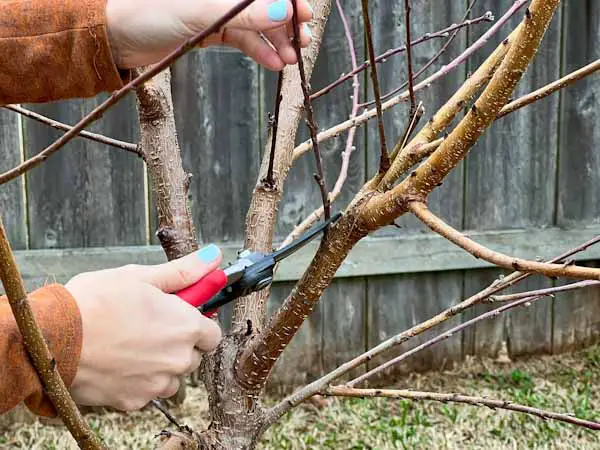
Cutting the tree back will keep its energy focused on developing fruit, rather than supporting a massive leafy canopy. It will also keep the tree size in check and make the ripe apricots reachable.
Summer pruning – or in the Texas heat, late spring pruning – is also a good idea. Thin out dense, leafy areas to improve airflow, increase sun exposure to the ripening apricots, and curtail any overly-long shoots. I do this in early May before it gets too hot, and while it can still benefit fruit quality.
Be aware that apricots bear fruit on 2-year-old (or older) spurs along the branches. If you prune away too much growth, you may remove more fruiting wood than you intended.
Delay Blooming as Late as Possible
As discussed above, late frosts are often the bane of apricot trees because they can damage buds, blossoms, or young fruit. But, there are a few things you can do (in addition to choosing a late-blooming variety) to help an apricot tree flower as late as possible.
Learn more: When Do Apricot Trees Flower? Best Varieties by Bloom Time
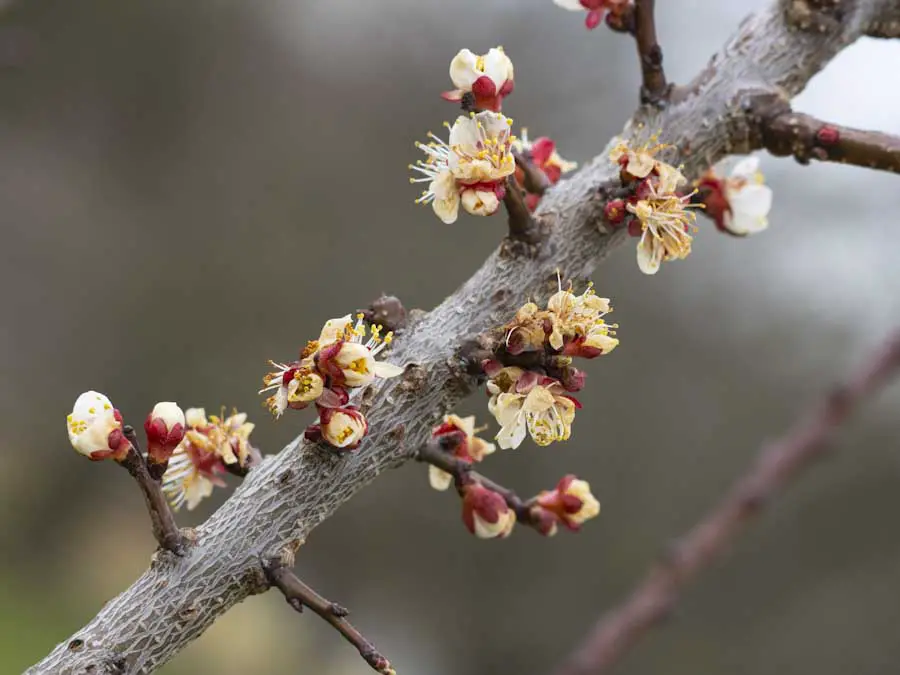
Paint the trunk of an apricot tree with a sun-reflecting coating to keep the tree cooler, longer. Use diluted white latex paint (half water, half paint) or an organic product such as IV Organic’s 3-in-1 Plant Guard.
(I like the Plant Guard because it not only protects against sunscald and heat, but it contains insect- and rodent-repelling natural ingredients. Get it on Amazon here, or use the code FRUIT10 for 10% off here.)
A thick layer of mulch – compost, pine bark, leaves, etc. – will also keep the roots from warming up as quickly in the spring sun. A cooler tree means later blooming. Even if it’s only by a few days, it may be enough to delay the young buds from being exposed to a damaging frost.
Two Trees are Better than One
Most apricot trees are self-fertile, so you don’t need to plant two trees in order to get fruit. However, planting a second tree for cross-pollination will significantly increase the quantity and quality of the apricot harvest. Consider finding space for two different apricot trees that bloom around the same time. If you want as many apricots as possible, two trees are definitely better than one.
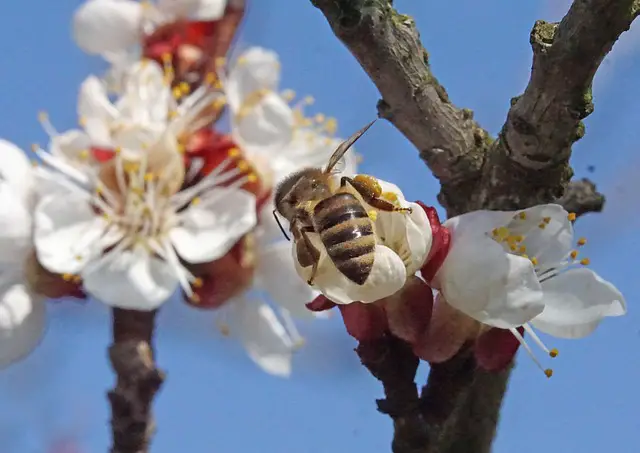
Choose the Right Variety
Cultivar choice is critical to successful apricot growing in Texas. Every climate and growing situation has unique factors to consider; chill hours, bloom time, disease resistance, size, and harvest timing are different for each region.
Choose a variety with a later bloom time for the best chance at beating spring frosts. Check that the chill hour requirement corresponds to the average chill hours in your area (to find your average chill hours, visit this site, click on the location nearest you, then click “Chill Units.”).
Related: The Tastiest Low-Chill Apricot Varieties to Grow at Home
Be mindful of harvest time so the apricots are ripe before the extreme summer heat sets in. And, if you know that you’re in an area with heavy disease pressure, choose a cultivar that’s known to be disease resistant.
The next sections details many Texas-friendly apricot varieties and their characteristics. There’s an apricot tree that will work for just about every location across the state.
The Best Apricot Varieties for Texas
The following apricot varieties are known to grow well in different Texas regions. I have attempted to compile as much helpful information as possible so you can determine what will work best for your situation. Wherever possible I’ve tried to include specifics about chill hours, hardiness zones, disease resistance, frost tolerance, soil adaptability, and other characteristics that are relevant to Texas growers.
‘Harglow‘

‘Harglow’ is a late-blooming apricot that is known to withstand late spring frosts well. It’s one of the most cold-hardy apricots and is best suited for North Texas and the Panhandle. It’s recommended for zones 5-8, but it needs at least 800 chill hours for fruiting.
The ‘Harglow’ tree is semidwarf (12-15 feet tall) and produces medium-large, bright orange sweet fruits that ripen in June. It’s resistant to brown rot and bacterial canker. Self-fertile.
‘Chinese‘

‘Chinese’ doesn’t bloom as late as some other varieties, but it’s known as one of the most frost-resistant apricots available. It needs 700 chill hours, and is suited for zones 4-8. The fruit is yellow-orange, semi-clingstone, and very heavy bearing in good years. ‘Chinese’ ripens in mid-June in most Texas locations. The tree will grow 15 to 20 feet tall. Self-fertile.
‘Tisdale‘
‘Tisdale is a lesser-known, local apricot variety available from Womack Nursery in Central Texas. It was originally found as a seedling by Roy Tisdale, and has been a very reliable producer for many Texas growers. ‘Tisdale’ may be hard to come by, but it produces a consistent crop of medium-sized, sweet apricots that ripen in May. Mid-late blooming. 600 chill hours.
‘Tomcot‘

Since it only needs 500 chill hours to fruit, ‘Tomcot’ can grow well in more southern parts of the state, even into zone 9. It blooms late and has a longer blooming period, making it resistant to frost. It ripens early, in late May to early June (depending on location).
‘Tomcot’ is partially self-fertile, so it will benefit from being near another apricot variety as a pollinizer. It doesn’t like too much moisture, as wet spring weather can lead it to develop rot. ‘Tomcot’ is a reliable producer of large, very sweet apricots.
‘Bryan‘
‘Bryan’ is another found seedling of unknown apricot parents. It has been known to bear well in many parts of Texas, and is sold by Bob Wells Nursery in Mineola, TX. ‘Bryan’ produces medium-sized apricots that ripen early (May-early June). It is self-fertile and need about 700 chill hours.
‘Tilton‘

This is another variety sold by Bob Wells Nursery, among others. (Note-if it’s sold by a Texas Nursery, it probably does well here!) It is mid-late blooming and resistant to frost damage. The apricots are medium sized and sweet-tangy, good for eating fresh, cooking, or canning. Ripens in June. Self-fertile. 600 chill hours.
‘Golden Sweet‘
‘Golden Sweet’ grows well here in East Texas. It is very vigorous in our warm spring temperatures and is a late bloomer, for an apricot. It has withstood March frosts well, even with a “false spring” in February. Although it’s often advertised as a “late season” apricot, for me it fruits in late May or early June.

‘Golden Sweet’ is known as a dependable apricot even in areas where apricots traditionally fruit inconsistently. It’s disease resistant and adaptable to different soils and climates. It’s the best-tasting apricot I’ve ever had – perfectly sweet, firm, and juicy when picked just as it starts to soften slightly. Self-fertile. 400-500 chill hours.
‘Gold Kist‘
‘Gold Kist’ is a good choice for the southern parts of Texas, as it only requires 300 chill hours. The tree stays relatively small, but it can be very heavy-bearing. ‘Gold Kist’ produces tons of sweet, golden-orange, firm-fleshed apricots. Its flowers can be damaged by spring frosts, so this is not for climates with fluctuating spring weather. Self-fertile. Zones 7-10.
‘Katy‘

This is another low-chill apricot for areas with mild winter weather. ‘Katy’ only needs 200-300 chill hours to fruit. It blooms early, so avoid planting this tree if frost is a concern. ‘Katy’ bears a heavy crop of mildly sweet apricots that ripen in May. It is adaptable to many soil types and is very drought-tolerant. Self fertile. Zones 7-10.
‘Blenheim‘

‘Blenheim’ is a long-popular apricot variety that is adaptable for many climates. It is early flowering, so it may fruit inconsistently in areas with late spring frosts or excessive spring moisture. ‘Blenheim’ produces apricots with outstanding flavor and firm, juicy texture. Self-fertile. 300-500 chill hours.
‘Golden Amber‘
‘Golden Amber’ is unique in that it has a long flowering time (about 30 days). This gives a better chance that at least some of the blossoms will survive a spring frost. The fruit also ripens gradually, making the harvest period longer than most other apricots.
The fruit has a high sugar content and is perfect for fresh eating, drying, or canning. Because of its long blossoming time it makes a great pollinator for other apricot varieties. Harvest mostly in June. Self-fertile. 600 chill hours, zone 6-8.

